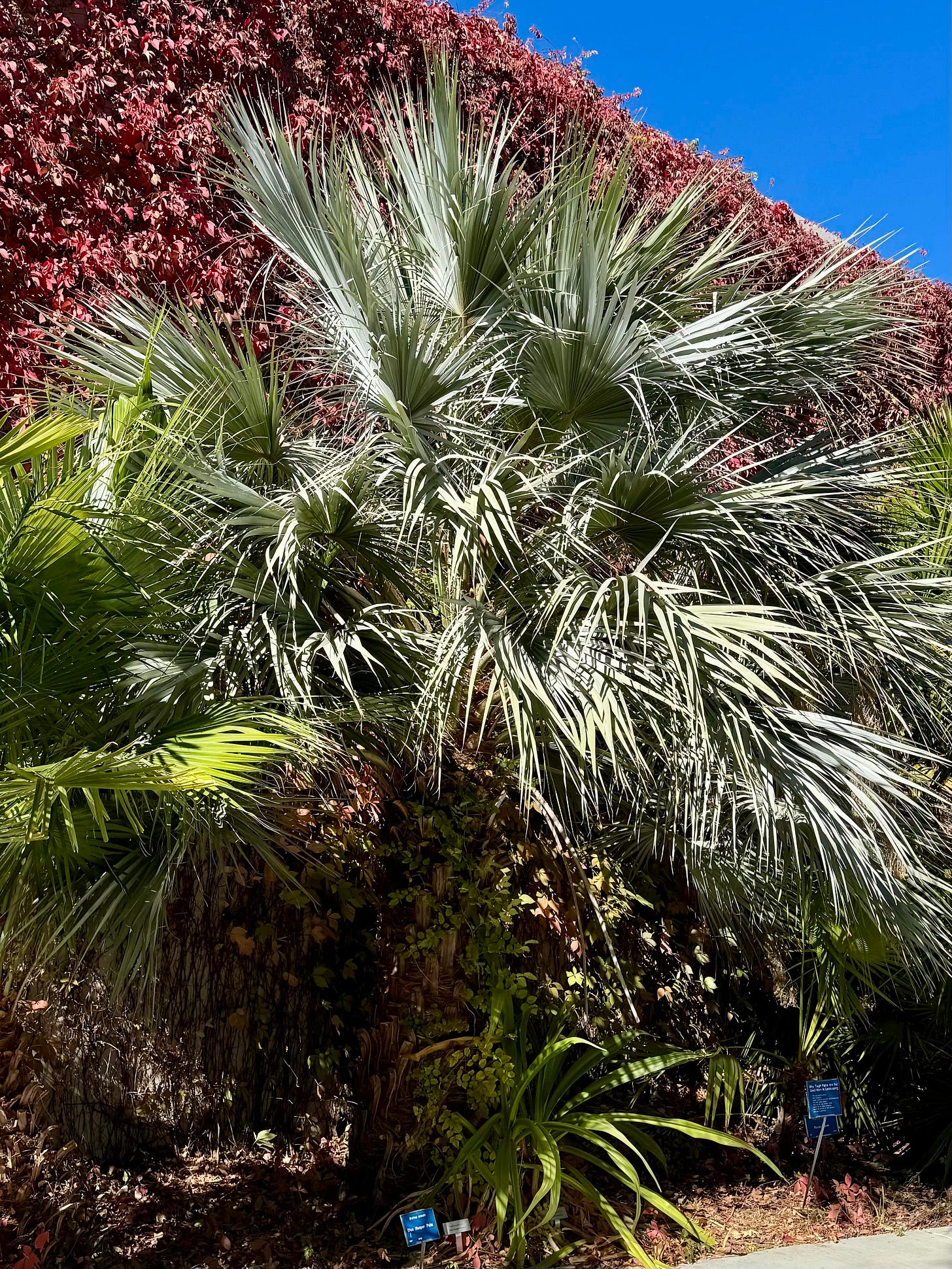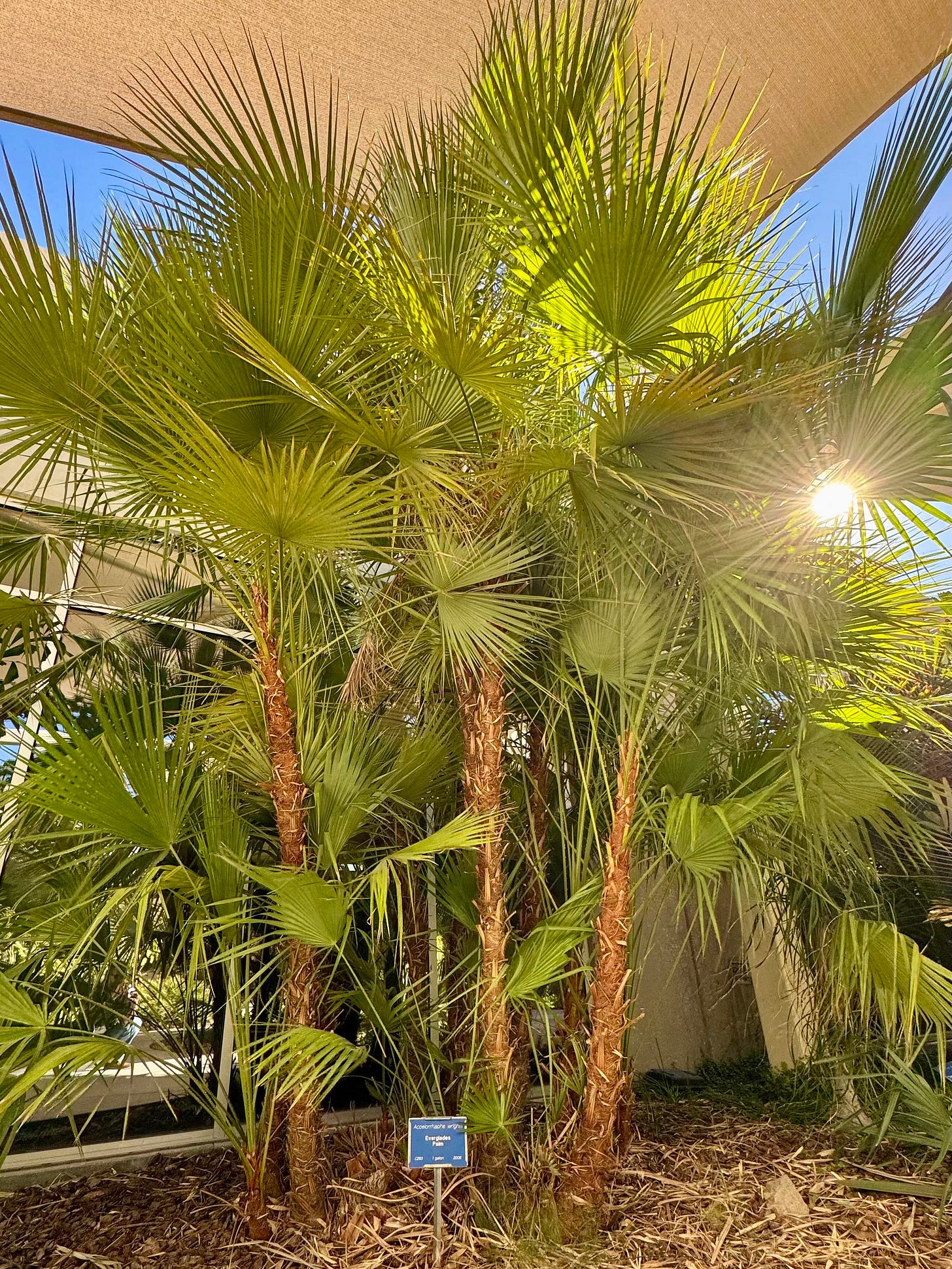Palm Trees and Poltergeist in the Desert Garden
Palm trees have developed a bad reputation in recent years for being greedy water wasters and high maintenance, but changing how, where, and what kinds we plant can make a difference
On late fall mornings, after strong winds have gusted all night long and stirred up the ancient and dry seabeds, and alkaline dust has blown up into the air before settling again like it has for millennia, there is the faint smell of brine in the air. I imagine I am at sea.
Though it may all be an effect of palm trees. They look like disconnected telephone polls had somehow sprouted canopies. But they are the sound of wind in the Las Vegas valley.
It is a sound I hate and adore because the winds are strong and ferocious, amplified by the whip and wing of these nearly-native trees (Washingtonia filifera in particular) that are unlike any tree that ever was. Stranger even than Joshua trees or giant aloes. Exotic in ways they are not.
When I was in high school we drove to Disneyland from Salt Lake City. On the way, we stayed a night in Las Vegas with my great aunts who lived in a small 1940s home just outside of downtown in a neighborhood full of old palms. My aunts were gay and bohemian and so unlike anyone or anything in 1990s northern Utah. Everything about Vegas was strange, new, and interesting.

We spotted palm trees first in St. George, a growing metropolis in Utah’s southwestern corner. Winters there are colder than Southern Nevada, but California palms (Washingtonia filifera), or some hybrid of them, grow fine. On our drive, they shouted to us that a place unlike any we had ever known was just a few hours away.
Palm trees have come to occupy the role aspens played for me in higher altitudes, and especially in the Salt Lake Valley where I gardened for most of my life. They are distinctive and complicated.
Both palms and aspens are wind personified. I've heard that the wind gently tickling aspen leaves, their fluttering and glittering, is the souls of lost loved ones visiting your garden. Wind rushing through palm fronds is a haunting. You have a poltergeist.
In higher altitude gardens, aspens are complicated because they need the much cooler temperatures and consistently moist soil that they get in their native ranges. They don’t grow well in valleys, despite the efforts of many gardeners who try.
Some consider palm trees, like aspens, unsuitable to low, desert valleys. While they were planted en masse in Las Vegas many years ago, they have since lost polite gardening’s good graces. They have a reputation for needing more water than they deserve.
The problem with palms isn’t how much water they need. Many handle the heat and do fine on impoverished watering schedules. The problem is with how we plant them. We grow them as solitary sentinels, forced to stretch and crane their lonely necks, as if they are desperately looking for a better place to grow, somewhere over the rainbow. I would want to escape the gravel pits of my neighbors’ front yards, too.
I have four palms in the garden I inherited, they stand at the corners of my lot as if they were planted to ward off evil spirits. Three of them are clearly California fan palms (Washingtonia filifera), the other is a hybrid of filifera, its trunk too thick and stout, its latticework too different.
Palms are Behemoth. Strong, powerful creatures that are best left growing as wild and free as God’s mythical beast in the Book of Job. But they are hardly solitary creatures. In their natural habitat they grow in groves, providing the shade in shady waterways.
Their big, great beards—the old palm fronds that hang dry and graceful from the tree—make them look like Tolkienian creatures. Wandering through one of these groves near a spring in Henderson, Nevada, I looked anxiously around for an arm to reach down and grab me and for a low, slow voice to demand a good excuse for my intrusion.

I recently visited the botanical gardens of the University of Nevada Cooperative Extension in Clark County where they care for a large collection of palms from all over the world. The horticulturists there have trialed them for years to understand which varieties grow best in our strong sun. While there are thousands of species of palms, only about eight are planted widely in the valley, according to researchers at the extension.
California and Mexican fan palms (Washingtonia robusta) are the most widespread. Blue hesper palms (Brahea armata) are arresting; they are hard to come by, but I see them around. Occasionally, an intrepid gardener, usually a California or Florida transplant, will attempt a pindo palm (Butia capitata) or a queen palm (Syagrus romanzoffian), though these look sad and ragged and even lonelier than the other lonely palms in our hot, dry valley. Researchers at the extension blame our dearth of palm varieties on the fact that they are slow growing, hard and expensive to source, and difficult to grow from seed.
The California fan palms in my yard seem not to know this, because they seed everywhere, particularly in the basins of newly planted shrubs and perennials. The pigeons at least come and eat many of the seeds—they must like the sweet, sticky seed coats.
Water requirements are often cited as a reason not to grow palms. But after established they do fine on a lean watering regimen. Their biology has made them very drought resistant.
Unlike other trees, that take up water and nutrients in a thin outer layer of cells just under their bark, palm trees are made of thick, water-carrying tubes that run up the center of the plant and provide nutrients and water to the fronds. Maureen Gilmer, a gardener in Palm Springs, describes palm physiology as being closer to a grass stem than a tree.
The best examples of well designed palm tree gardens feature many palms grown tightly together, much closer than you would dare plant them. In this way, they shade each other and create microclimates that are welcoming to both people and plants. At the University’s botanical garden, in a sheltered courtyard, there is a palm tree forest. The air is clean and thick with their transpiration. It’s a design style worth emulating.
Pick a sheltered area around your home, a side yard would work, or a northeastern exposure, where the morning light is gentle and accommodating as you enjoy a cup of coffee on an early summer day. Plant three to five palms. I might try this myself with a blue hesper palm (Brahea armata), an Everglades palm (Accelorrhaphe wrightii), a radicalis palm (Chamaedorea radicalis), and a lady palm (Rhapis excelsa), four types I fell in love with at my recent visit. They will join the California palm that is already there.
Of course, these palms will be difficult to source, if not exactly difficult to grow, so it will all depend on whether or not I can get my hands on them.
I am of the gardening type that often finds a good reason to plant something after being told not to. Recent disclamations of palms, rooted in their messy flowers and seeds and fears of their watering needs, may be warranted. But planting a little grove of my own to increase the humidity in my garden and offer more shade seems like a good use of my watering budget. I’ve no turf, and grow mostly desert trees. To make up for it, I’ll restrict my watering elsewhere.





